
Dennis Lee Hopper was an American actor and film director. He is known for his roles as mentally disturbed outsiders and rebels. He earned prizes from the Cannes Film Festival and Venice International Film Festival as well as nominations for two Academy Awards, a Primetime Emmy Award and two Golden Globe Awards. Hopper studied acting at the Old Globe Theatre in San Diego and the Actors Studio in New York. Hopper also began a prolific and acclaimed photography career in the 1960s.
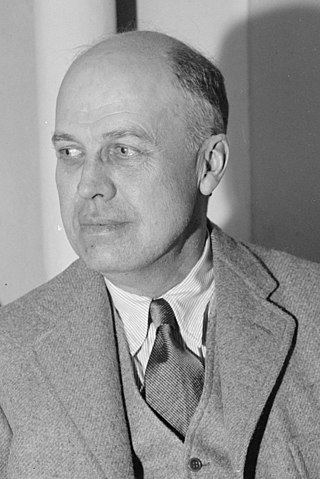
Edward Hopper was an American realist painter and printmaker. While he is widely known for his oil paintings, he was equally proficient as a watercolorist and printmaker in etching.

Nyack is a village located primarily in the town of Orangetown in Rockland County, New York, United States. Incorporated in 1872, it retains a very small western section in Clarkstown. The village had a population of 7,265 as of the 2020 census. It is a suburb of New York City lying approximately 15 miles (24 km) north of the Manhattan boundary near the west bank of the Hudson River, situated north of South Nyack, east of Central Nyack, south of Upper Nyack, and southeast of Valley Cottage.

Sharon is a town in Windsor County, Vermont, United States. It had a population of 1,560 at the 2020 census.
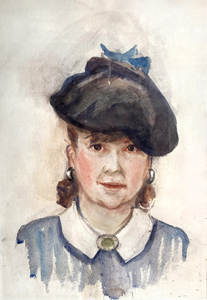
Josephine Verstille Hopper was an American painter who studied under Robert Henri and Kenneth Hayes Miller, and won the Huntington Hartford Foundation fellowship. She was the wife of Edward Hopper, whom she married in 1924.
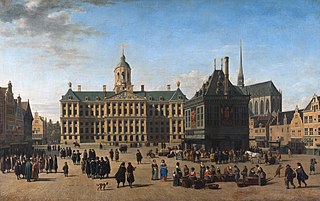
In the visual arts, a cityscape is an artistic representation, such as a painting, drawing, print or photograph, of the physical aspects of a city or urban area. It is the urban equivalent of a landscape. Townscape is roughly synonymous with cityscape, though it implies the same difference in urban size and density implicit in the difference between the words city and town. In urban design the terms refer to the configuration of built forms and interstitial space.

Nighthawks is a 1942 oil-on-canvas painting by the American artist Edward Hopper that portrays four people in a downtown diner late at night as viewed through the diner's large glass window. The light coming from the diner illuminates a darkened and deserted urban streetscape.

Chop Suey (1929) is an oil painting on canvas by the American artist Edward Hopper. The foreground of the work portrays two women in conversation at a restaurant. In November 2018, it was sold at $92 million, a record price for the artist's work.
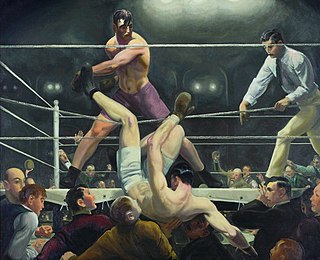
American Realism was a style in art, music and literature that depicted contemporary social realities and the lives and everyday activities of ordinary people. The movement began in literature in the mid-19th century, and became an important tendency in visual art in the early 20th century. Whether a cultural portrayal or a scenic view of downtown New York City, American realist works attempted to define what was real.

The secretary of state of Arkansas is one of the elected constitutional officers of the U.S. state of Arkansas.

Platylesches is a genus of skipper butterflies in the family Hesperiidae, commonly called hoppers, found in Africa.
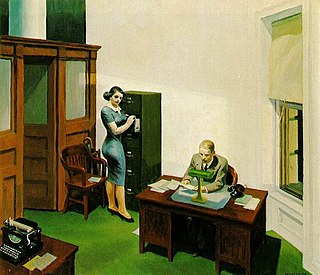
Office at Night is a 1940 oil-on-canvas painting by the American realist painter Edward Hopper. It is owned by the Walker Art Center in Minneapolis, Minnesota, which purchased it in 1948.

Hotel Lobby is a 1943 oil painting on canvas by American realist painter Edward Hopper; it is held in the collection of the Indianapolis Museum of Art (IMA), in Indianapolis, Indiana, United States.
E.J. Babille was born Edward Julius Babille in Milwaukee, Wisconsin. He was an American assistant director in the silent and early sound film eras.
Edward Mortimer Morris Warburg was an American philanthropist and patron of the arts from New York City. He taught Modern Art at Bryn Mawr College and he was vice director for public affairs of the Metropolitan Museum of Art. He was a co-founder of the American Ballet and the School of American Ballet. He collected many paintings and sculptures, and donated the bulk of them to museums, especially the Museum of Modern Art.

Sharon Douglas was an American film and radio actress, most active in the 1940s and 1950s.
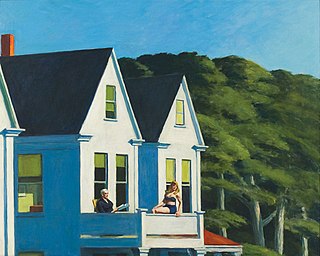
Second Story Sunlight is a 1960 oil painting by the American artist Edward Hopper. It depicts two women of different ages on the second-story balcony of a white house. The older woman reads a newspaper while the younger woman sits on the railing. It is in the collections of the Whitney Museum of American Art, in New York.
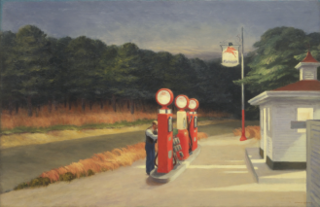
Gas is an oil painting by the American painter Edward Hopper, from 1940. It depicts an American gas station at the end of a highway. The painting belongs to the Museum of Modern Art, in New York.

High Noon is an 1949 oil painting by the American Realist artist Edward Hopper, created in 1949. The work depicts a woman standing and staring outward from the doorway of a home, with the sun casting a split shadow over the home.

Ground Swell is a 1939 painting by American artist Edward Hopper which depicts five people on a heeling catboat in a light swell, looking at an ominous buoy. It was in the collection of the Corcoran Gallery of Art from 1943 until it was purchased by the National Gallery of Art in Washington, D.C. in 2014.


















